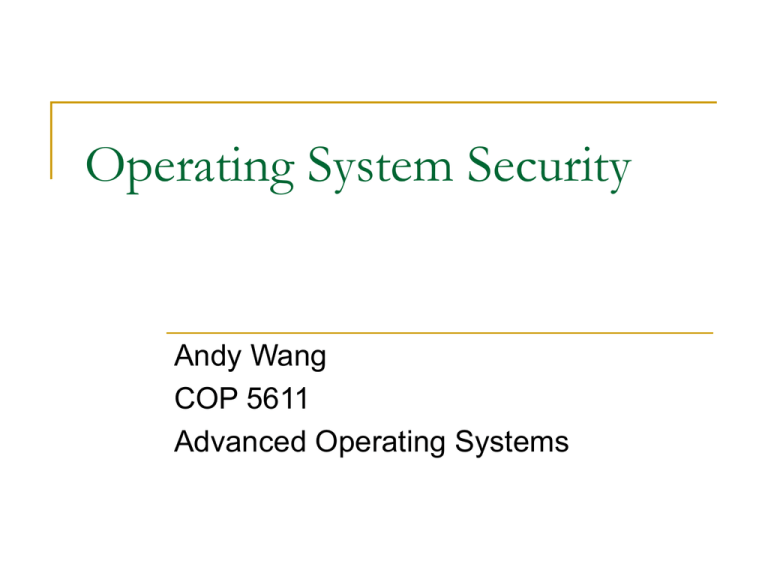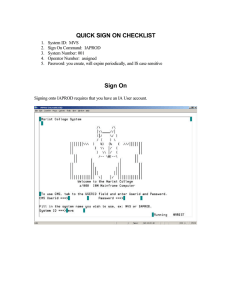Operating System Security Andy Wang COP 5611 Advanced Operating Systems
advertisement

Operating System Security Andy Wang COP 5611 Advanced Operating Systems Outline Introduction Threats Basic security principles Security on a single machine Distributed systems security and data communications security Introduction Security is an engineering problem Always a tradeoff between safety, cost, and inconvenience Not much solid theory in the field Hard to provide any real guarantees Because making mistakes is easy And the nature of the problem implies that mistakes are always exploited History of Security Problem Originally, there was no security problem Later, there was a problem, but nobody cared Now, there are increasing problems, and people are beginning to care Fundamental Constraints of Practical Computer Security Security costs If too much, it won’t be used If it isn’t easy, it won’t be used Misuse often makes security measures useless Fit the stringency of the measure to the threat being countered Security is as Strong as the Weakest Link Those breaking security will attack the weakest point Putting an expensive lock on a cheap door doesn’t help much Must look on security problems as part of an integrated system, not just a single component Security Threats Extremely wide range of threats From a wide variety of sources Requiring a wide variety of countermeasures Generally, countering any threat costs something So people frequently try to counter as few as they can afford Physical Security Some threats involve access to the equipment itself Such as theft, destruction tampering Physical threats usually require physical prevention methods Social Engineering and Security Computer security easily subverted by bad human practices E.g., giving key out over the phone to anyone who asks Social engineering attacks tend to be cheap, easy, effective So all our work may be for naught A Classification of Threats Viewed as types of attacks on normal service So what is normal service? Information Source Information Destination Classification of Threat Types Secrecy Integrity Availability Exclusivity Interruption Information Source Information Destination Interruption Threats Denial of service Prevents source from sending information to receiver Or receiver from sending request to source A threat to availability How Does an Interruption Threat Occur? Destruction of HW/SW Interference with communications channel Overloading a shared resource Interception Information Source Information Destination Unauthorized Third Party Another Type of Interception Information Source Information Destination Unauthorized Third Party Interception Threats Data or services provided to unauthorized party Either in conjunction with or independent of authorized access A threat to secrecy Also a threat to exclusivity How Do Interception Threats Occur? Eavesdropping Masquerading Break-ins Illicit data copying Modification Information Source Information Destination Unauthorized Third Party Another Type of Modification Threat 3 2 1 Information Source Information Destination Unauthorized Third Party Modification Threats Unauthorized parties modify data Either on the way to the users Or permanently at the servers A threat to integrity How Do Modification Threats Occur? Interception of data requests Masquerading Illicit access to servers/services Fabrication Information Source Information Destination Unauthorized Third Party Fabrication Threats Unauthorized party inserts counterfeit objects into the system Causing improper changes in data Or improper use of system resources A threat of integrity How Do Fabrication Threats Occur? Masquerading Bypassing protection measures Duplication of legitimate requests Active Threats vs. Passive Threats Passive threats are forms of eavesdropping No modifications, injections of requests, etc. occur Active threats are more aggressive Passive threats are mostly to secrecy Active threats are to availability, integrity, exclusivity What Are We Protecting Hardware Software Data Communications lines and networks Economic values Basic Security Principles Terms and concepts Mechanisms Security and Protection Security is a policy Protection is a mechanism E.g., “no unauthorized user may access this file” E.g., “the system checks user identity against access permissions” Protection mechanisms implement security policies Design Principles for Secure Systems Economy Complete mediation Open design Least privilege Least common mechanism Acceptability Fail-safe defaults Economy in Security Design Economical to develop And to use Should add little of no overhead Should do only what needs to be done Generally, try to keep it simple and small Complete Mediation Apply security on every access to an object that a mechanism is meant to protect E.g., each read of a file, not just the open Does not necessarily require actual checking on each access Open Design Don’t rely on “security through obscurity” Assume all potential intruders know everything about the design And completely understand it Separation of Privileges Provide mechanisms that separate the privileges used for one purpose from those used for another To allow flexibility in the security system E.g., separate access control on each file Least Privilege Give bare minimum access rights required to complete a task Require another request to perform another type of access E.g., don’t give write permission if he only asked for read Least Common Mechanism Avoid sharing parts of the security mechanism among different users Coupling users leads to possibilities for them to breach the system Acceptability Mechanism must be simple to use Simple enough that people will use it automatically Must rarely or never prevent permissible accesses Fail-Safe Designs Default to lack of access So if something goes wrong/is forgotten/isn’t done, no security is lost If important mistakes are made, you’ll find out about them Without loss of security Sharing Security Spectrum No protection Isolation Share all or nothing Share with access limitations Share with dynamic capabilities Important Security Mechanisms Authentication Encryption Passwords Other authentication mechanisms Access control mechanisms Authentication If a system supports more than one user, it must be able to tell who’s doing what I.e.: all requests to the system must be tagged with user identity Authentication is required to assure system that the tags are valid Encryption Various algorithms can be used to make data unreadable to intruders This process is called encryption Typically, encryption uses a secret key known only to legitimate users of the data Without the key, decrypting the data is computationally infeasible Encryption Example M is the plaintext ( text to be encrypted) E is the encryption algorithm Ke is the key C is the ciphertext (encrypted text) C = E(M, Ke) Decrypting the Ciphertext C is the ciphertext D is the decryption algorithm Kd is the decryption key M = D(C, Kd) Symmetrical Encryption Many common encryption algorithms are symmetrical I.e.: E = D and Ke = Kd Some important encryption algorithms are not symmetrical, however Encryption Security Assumptions Assume that someone trying to break the encryption knows: The algorithms E and D Arbitrary amounts of matching plaintext and ciphertext M and C But does not know the keys Ke and Kd Evaluating Security of Encryption Given these assumptions, and a new piece of ciphertext Cn, how hard is it to discover Mn? Either by figuring out Kd or some other method What if Mn matches one of the known pieces of plaintext? Practical Security of Encryption Most encryption algorithms can be broken Goal is to make breaking them too expensive to bother How do we protect our encryption? Key Issues in Encryption Security often depends on length of key Long keys give better security But slows down encryption The more data sent with a given key, the greater the chance of compromise The more data sent with a given key, the greater the value of deducing it One-Time Pads Theoretically unbreakable security A symmetrical encryption system Use one bit of key for each bit of plaintext Never reuse any key bits Generate key bits truly randomly Advantages of One-Time Pads Proved secure (in information theoretic sense) Encryption algorithm is computationally cheap XOR message with key Required procedures for proper use well understood Problems with One-Time Pads They burn keys like crazy Need to keep key usage in sync If the keys aren’t truly random, patterns can be deduced in the bits Distribution of pads Passwords A fundamental authentication mechanism A user proves his identity by supplying a secret Either at login or other critical time The secret is the password Password Security Password selection Password storage and handling Password aging Selecting a Password Desirable characteristics include: Unguessable Easy to remember (and type) Not in a dictionary Too long to search exhaustively Password Storage and Handling Passwords are secrets, so their security depends on careful handling But seemingly the system must store the password To compare when users log in If system storage is compromised, so is all authentication Securely Storing Passwords Store only in encrypted form To check a password, encrypt it and compare to the encrypted version Encrypted version can be stored in a file But there are tricky issues Tricky Issues in Storing Encrypted Passwords What do I encrypt them with? If I use single key to encrypt them all, what if the key is compromised? That key must be stored in the system What if two people choose the same password? Example: The UNIX Password File Each password has an associated salt UNIX encrypts a block of zeros Key built from password plus 12-bit salt Encryption done with DES Stored information = E(zero, salt + password) To check password, repeat operations How Does This Help the Problems? No single key for encryption So can’t crack that key And needn’t ever store it Each encryption (probably) performed with a different key So two people with the same password have different encrypted versions Does this solve the problem? Not entirely Passwords exist in plaintext in process checking them Passwords may travel over communication lines in plaintext Especially for remote logins Or logins over modems Problems with Passwords People choose bad ones People forget them People reuse them People rarely change them How to Deal with Bad Passwords Educate users so they choose good ones Automatic password generation Check when changed Periodically run automated cracker Any solution must balance user needs, password security, and resources Other Authentication Mechanisms Challenge/response Smartcards Other special hardware Detection of personal characteristics All have some drawbacks Some are combined with passwords Data Access Control Mechanisms Methods of specifying who can access what in which ways when Based on assumption that the system has authenticated the user Access Matrix Describes permissible accesses for the system Subjects access objects with particular access rights A theoretical concept, never kept in practice Access Matrix Example File 1 File 2 Server X Segment 57 User A Read, Write None Query Read User B Read Write Update None User C None Read Start, Stop None User D None None Query None Methods for Implementing Access Matrix Access control lists Decomposition by columns Capabilities Decomposition by rows Access Control Lists Each object controls who can access it Using an access control list Add subjects by adding entries Remove subjects by removing entries + Easy to determine who can access object + Easy to change who can access object - Hard to tell what someone can access Access Control List Example File 1’s ACL User A: Read, Write User B: Read Segment 57’s ACL User A: Read Capabilities Each subject keeps track of what it can access Typically by keeping a capability for each object Capabilities are like admission tickets + Easy to tell what a subject can access - Hard to tell who can access an object - Hard to revoke/control access Capability Example User A’s Capabilities File 1: Read, Write Server X: Query Segment 57: Read User B’s Capabilities File 1: Read File 2: Write Server A: Update Other Models of Access Control Military model Information flow models Lattice model of information flow



